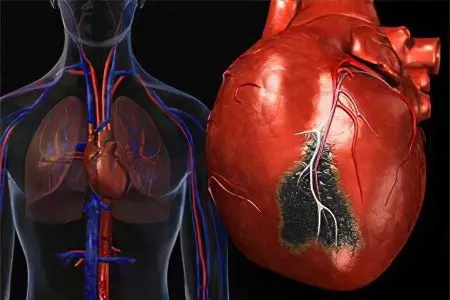Contents
- What is a massive heart attack?
- Symptoms of a massive heart attack
- Causes of a massive heart attack
- Stages of a massive heart attack
- Consequences of a massive heart attack
- What are the chances of surviving after a massive heart attack?
- How long do people live after a massive heart attack?
- Treatment and rehabilitation after a massive heart attack
What is a massive heart attack?
extensive myocardial infarction – this is ischemia and tissue necrosis, covering large areas of the heart muscle. An extensive heart attack is a very severe pathology, in which about 40% of patients die without waiting for medical help. Most often, an extensive infarction is transmural, when all layers of the myocardium undergo necrosis.
Extensive infarction is included in the classification of myocardial infarctions, and in terms of prevalence it ranks third after small-focal and large-focal lesions. Extensive heart attacks provoke intoxication of the body with tissue decay products, and necrotic masses in the center of the focus can persist for not only weeks, but even months.
Symptoms of a massive heart attack

The symptoms of a large infarction are almost impossible to distinguish from the symptoms of a small focal infarction. In the same way, it is impossible to determine with 100% accuracy only by clinical signs the area that has undergone a lesion.
However, for an extensive heart attack, more pronounced symptoms of the ongoing pathological process are most often characteristic, among them:
Severe pain that comes on suddenly. They are localized behind the sternum, may have a different character (burning, cutting, pressing, bursting);
Pain is prolonged, it is not possible to eliminate them by taking Nitroglycerin;
The pain may radiate to the shoulder blades, to the neck, to the right shoulder;
There is profuse sweating with the appearance of sticky cold sweat;
The expressed general weakness is characteristic of extensive defeat of a cardiac muscle;
A person has a fear of death, an increased sense of anxiety.
The described symptoms occur in 75-90% of patients and characterize the typical form of a heart attack.
If we consider atypical variants of the course of an extensive heart attack, then the symptoms will be somewhat different:
Asthmatic infarction is characterized by the appearance of suffocation and shortness of breath, palpitations and orthopnea. The pains are mild, or they are absent at all;
The gastralgic variant of an extensive heart attack manifests itself in pain that is localized in the upper abdomen. In parallel, there are dyspeptic disorders;
With an arrhythmic variant of the course of an extensive heart attack, an increased heartbeat, disturbances in the work of the heart, its “fading” come to the fore;
With a cerebrovascular form of a heart attack, symptoms such as dizziness, loss of consciousness, nausea and vomiting are observed.
An asymptomatic form of the course of the disease with extensive infarction practically does not occur.
Causes of a massive heart attack

The cause of an extensive heart attack in 98% of cases is an acute manifestation of coronary heart disease, in which the coronary arteries undergo atherosclerotic changes. Thrombosis of the coronary arteries in the last century was considered the only cause of a massive heart attack.
At the moment, there are several more reasons why this heart pathology can develop:
Congenital malformations of the coronary arteries;
Blockage of large arteries by parts of the tumor, vegetations;
Inflammatory processes affecting the coronary arteries of the heart;
The formation of a hematoma near the mouth of the coronary artery as a result of dissection of the ascending aorta;
Thrombosis of the coronary artery due to DIC;
Oncological formations of the heart. In this case, an extensive heart attack can occur due to tumor necrosis, due to blockage of the coronary artery by it.
Extracardiac oncological formations that grow and metastasize to the coronary artery;
The use of drugs that provoke spasm of the coronary arteries (amphetamine, cocaine);
Injuries of mechanical origin, as well as electric shock;
Iatrogenicity due to surgical interventions on the heart and on the coronary artery.
An extensive infarction differs from a small-focal myocardial lesion in that an obstruction that disrupts blood flow occurs in a larger artery. Occlusion, as a rule, is exposed to the main trunk of the left coronary artery.
The size of the heart attack is determined by the following factors:
The degree of stenosis of the coronary arteries;
The degree of violation of collateral circulation;
The level of overlap of the arterial trunk (embolism or thrombosis);
functionality of the myocardium.
The higher the degree of violations, the more extensive will be the area of damage to the heart.
Stages of a massive heart attack
Considering the stages of an extensive infarction, five consecutive periods can be distinguished:
The prodromal stage, during which angina attacks intensify. The duration of this stage is from several hours to several weeks;
The most acute stage, during which ischemia manifests itself, followed by the appearance of a site of myocardial necrosis. The duration of this stage is from 20 minutes to 2 hours;
The acute stage, during which myocardial necrosis continues, followed by enzymatic fusion of the damaged muscle tissue of the heart (tissue myomalacia). The duration of this stage is from two days to two weeks;
The subacute stage, during which the processes of tissue scarring are triggered, and the areas that have undergone necrosis are replaced by granulation tissue. This stage lasts 1-2 months;
The post-infarction stage, during which the scar continues to form, and the myocardium adapts to the new conditions in which it has to function.
Consequences of a massive heart attack

The severity of organic damage to the heart causes serious consequences of an extensive heart attack, including:
Rupture of the heart muscle, which is most often observed in patients who have had a transmural infarction for the first time. Lethal outcome in this case always occurs. Rupture of the heart usually occurs on the first day after the manifestation of an extensive infarction, the anterior wall of the left ventricle is damaged mainly;
Cardiogenic shock, which is formed most often with an extensive anterior infarction against the background of damage to the coronary arteries and with necrosis of more than 40% of the mass of the myocardium of the left ventricle. If a patient has a true cardiogenic shock, then the mortality rate reaches 90%. It is expressed in tachycardia, lethargy and weakness. The skin becomes very pale, their humidity rises, blood pressure drops sharply;
Pulmonary edema. First, the patient develops interstitial pulmonary edema, which, in the absence of adequate assistance, turns into alveolar edema with shortness of breath, weakened breathing, wet rales, cough with foamy pink sputum. Mortality in myocardial infarction complicated by pulmonary edema reaches 25%.
In addition, the consequences of a massive myocardial infarction are mitral valve insufficiency (25-50% of patients), left ventricular aneurysm (7-15% of patients), post-infarction syndrome (4-10% of patients), thromboembolism (10-15% of patients), disorders heart rhythm, atrial fibrillation, ventricular arrhythmias, sinus tachycardia and bradycardia.
What are the chances of surviving after a massive heart attack?
Statistics indicate that after suffering a massive heart attack, about 40% of patients die at the pre-hospital stage. No specialist can unequivocally answer the question regarding the chances of surviving after a massive heart attack.
However, the risk of death can be calculated using the GRACE rating scale. It should be noted that a large area of myocardial damage is considered an unfavorable prognostic factor, as well as the patient’s advanced age, high blood pressure, the presence of signs of congestive heart failure, etc. high).
How long do people live after a massive heart attack?
Many factors affect life expectancy after a massive heart attack. If in the early period it is the presence of complications, the extent of the lesion, the age of the patient, then in the later period it is the observance of the doctor’s recommendations and the maintenance of a healthy lifestyle. To prolong life, it is necessary to take medications, not violate the treatment regimen, give up bad habits, and reduce excess body weight.
It is worth considering that if after a small focal infarction it may take about 8 weeks to recover, then after an extensive heart attack, often six months is not enough.
If we turn to statistics, it indicates that 19% of patients do not cross the five-year survival threshold and die either due to a recurrence of a heart attack or due to its complications.
Treatment and rehabilitation after a massive heart attack

Treatment and rehabilitation of a patient with a massive heart attack should be carried out under the strict supervision of a physician in a hospital setting. Every person with suspected myocardial infarction is urgently admitted to the intensive care unit.
Elimination of pain syndrome. Prior to the arrival of paramedics, patients most often take Nitroglycerin 0,5 mg under the tongue, which helps to reduce pain. The medication can be repeated. When relief does not occur, the doctors who came to the call administer narcotic analgesics to the patient as soon as possible. If this is not done, then the risk of expanding the necrosis zone increases significantly, which is due to the activation of the sympathetic nervous system against the background of a pain attack. For this purpose, Morphine sulfate is used intravenously. If the patient vomits or is very sick, then he is given up to 20 mg of metoclopramide.
Oxygenotherapy. Oxygen is prescribed to all patients with myocardial infarction against the background of heart failure, cardiogenic shock, respiratory disorders.
antiplatelet therapy. All patients are prescribed Aspirin, regardless of how long ago the disease occurred.
Thrombus destruction. The thrombus is eliminated using thrombolytic therapy (Streptokinase, Anistreplase, Alteplase, Urokinase) or it is destroyed mechanically. If both of these methods do not lead to the normalization of blood flow, then it is possible to perform coronary artery bypass grafting.
As for the rehabilitation of patients with extensive heart attack, it comes down to the following activities:
Performing therapeutic exercises. Physical activity should be dosed, initially exercises must be performed under strict medical supervision. A well-built scheme allows patients to recover faster after prolonged immobilization;
Compliance with a strict diet. Emphasis should be placed on food of plant origin, meat should be chosen dietary varieties (poultry, lean fish). Sour-milk drinks should be on the table every day. It is important to limit your salt intake. Products should not increase the level of cholesterol in the blood, which means that it is necessary to stop eating egg yolk, liver, caviar, fried and fatty foods;
Drug correction of arrhythmia, blood pressure, cardiovascular insufficiency. Patients are prescribed lipid-lowering drugs (Atorvastatin, Pravastatin, Simvastatin), antiplatelet agents (Aspirin, Ticlopidin, Clopidogrel), ACE inhibitors, beta-blockers (Timolol, Metoprolol, Carvedilol, etc.);
Psychological rehabilitation. Patients after a heart attack continue to fear a second attack, are confused about the prospects for further personal and social life. In order for all these worries not to turn into neuroses and not aggravate the course of the disease, it is necessary to provide the patient with competent psychological assistance;
Sanatorium treatment at specialized resorts;
Rejection of bad habits.
Properly built rehabilitation can significantly extend the life of patients after extensive myocardial infarction.
[Video] Dr. Berg – PREVENTION OF HEART DISEASE. How to avoid a heart attack?









